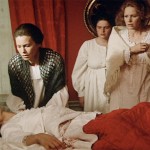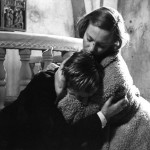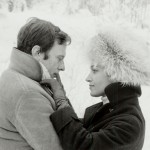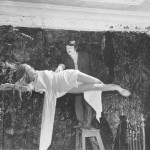By Andrei Tarkovsky
My hope is that those readers whom I manage to convince, if not entirely then at least in part, may become my kindred spirits, if only in recognition of the fact that I have no secrets from them. — Tarkovsky
I’ve never read another book like Sculpting in Time. In it Tarkovsky speaks as eloquently about art as he does faith and philosophy, and does so in a remarkably kind, concerned voice. To him, his subject —the unique ability of the cinematic image to touch the soul and inspire spiritual improvement — is quite literally a matter of life and death. “The goal for all art,” he writes, “unless of course it is aimed at the ‘consumer’, like a saleable commodity, is to explain to the artist himself and to those around him what man lives for, what is the meaning of his existence. To explain to people the reason for their appearance on this planet; or if not to explain, at least to pose the question” (36). And again: “The aim of art is to prepare a person for death, to plough and harrow his soul, rendering it capable of turning it to good” (43).
That we understand the gravity of this statement is more than a simple intellectual or rhetorical exercise for Tarkovsky. Throughout the book (but most notably in its “Conclusion”) he speaks in the voice of a trusted elder, as if determined to pass along the wisdom gained from experience and inspiration while time allows. That he was already suffering from terminal cancer when completing the book makes it all the more affecting.
In the closing paragraph of Sculpting in Time, Tarkovsky makes his final appeal, speaking to us as confidants:
Finally, I would enjoin the reader — confiding in him utterly — to believe that the one thing that mankind has ever created in a spirit of self-surrender is the artistic image. Perhaps the meaning of all human activity lies in artistic consciousness, in the pointless and selfless creative act? Perhaps our capacity to create is evidence that we ourselves were created in the image and likeness of God? — Tarkovsky
In the margin of my copy I scribbled, “Now that is how to finish a book.” Although my own appreciation of his sentiment is due, in large part, to our shared religious faith, I trust that such a faith is by no means a prerequisite for his readers. I can’t stress enough how refreshing it is to read a filmmaker speak of his craft using terms like “truth,” “love,” “sacrifice,” and (especially) “beauty.” Tarkovsky writes, “We have almost totally lost sight of the beautiful as a criterion of art” (168). It’s a criticism of the commercial cinema that is both blatant and absurd — in an era when weekend box office grosses have become the stuff of water-cooler conversations, the word “beauty” is as alien to “movies” as Tarkovsky himself is to most American movie-goers.
The greatest compliment I can give Sculpting in Time is to say that when I finished reading it I took a deep breath and watched his film, The Mirror, three times. Forgive my hyperbole, but Tarkovsky has quite honestly challenged me to adjust my entire understanding of film and of its potential.
Much of Sculpting in Time is devoted to Tarkovsky’s fascinating and detailed explanation of his methods as a filmmaker. He addresses both his stylistic techniques and, more specifically, how he put them into practice in each of his seven films (Ivan’s Childhood, The Mirror, and The Sacrifice are given the most attention; Stalker and Solaris the least). Chapter V is the longest chapter and should probably be the starting point for anyone who is interested in Tarkovsky, but not in reading the entire book. The chapter is broken into six film elements:
The Film Image
Tarkovsky begins the chapter by acknowledging that a concept like “artistic image” could never be “expressed in a precise thesis, easily formulated and understandable” (104). And that is precisely the point. For him, the potential of cinema lies in the unique ability of the film image to communicate Truth more effectively (or affectively) than language. The image is able to reveal the totality of the universe and allows the viewer to experience simultaneously complex and contradictory feelings.
Tarkovsky argues that such an image is captured only when the director abandons all attempts at objectivity, building instead from his own personal storehouse of memory and experience. The Mirror is the most obvious example of this principle put to practice — it is a film filled with images from Tarkovsky’s own childhood. His approach to the film image (in a nutshell) is that an image based on Truth (even a completely subjective truth) will resonate much more strongly with an audience than will a cliched image that comes pre-loaded with supposedly objective symbolism. Works for me. I can barely make it through The Mirror without crying.
Time, Rhythm and Editing
“Sculpting in time” is Tarkovsky’s metaphor for the construction of a film’s rhythm. Notice that the emphasis is put on time and rhythm, rather than on editing, which Tarkovsky considers little more than an assembly process. This distinction clearly separates him from his Soviet predecessors like Eisenstein, Pudovkin, and Kuleshov, whose experiments in montage Tarkovsky refers to as “puzzles and riddles,” intellectual exercises that require too little of the audience.
Instead, he writes, “rhythm . . . is the main formative element of cinema” (119). He uses a short film by Pascal Aubier to illustrate his point. The ten-minute film contains only one shot: the camera begins on a wide landscape, then zooms in slowly to reveal a man on a hill. As the camera gets closer, we learn first that the man is dead, then that he has been killed. “The film has no editing, no acting and no decor,” Tarkovsky writes. “But the rhythm of the movement of time is there within the frame, as the sole organising force of the — quite complex — dramatic development” (114). Like the Aubier example, Tarkovsky’s films are marked by long takes (most notably in the bookends of The Sacrifice) and slow, beautifully choreographed camera movements.
Scenario and Shooting Script
For Tarkovsky, the greatest challenge associated with developing a script is maintaining the integrity of the film’s inspiration — “it almost seems as if circumstances have been deliberately calculated to make [the director] forget why it was that he started working on the picture” (125). For this reason, he argues that the director must also be the writer, or he must develop a partnership that is founded on complete trust. The majority of this section is devoted to The Mirror — Tarkovsky uses it as a case study of his method. Fascinating reading.
The Film’s Graphic Realisation
This section offers a glimpse of how Tarkovsky worked on set, describing his approach to collaboration. “It is essential that [the crew] should not be in any way mere functionaries; they have to participate as creative artists in their own right, and be allowed to share in all your feelings and thoughts” (135). He talks specifically about his relationship with the camera-man, who he refers to as a “co-author,” and explains how he worked with Georgi Rerberg and Vadim Yusov. This section is featured prominently in Directed by Andrey Tarkovsky, the documentary that is included on The Sacrifice DVD.
The Film Actor
Again, Tarkovsky’s approach (in this case, to directing actors) is a distinct break from the Soviet tradition, particularly that of Stanislawski. While he sees much value for the theater in what has become known as method acting, he argues that film actors, like their directors, should find inspiration in subjective experience. “The one thing the film actor has to do is express in particular circumstances a psychological state peculiar to him alone, and do so naturally, true to his own emotional and intellectual make-up, and in the form that is only right for him” (141). Free to perform without restraint, the actors then provide the director true experience from which he selects the “stuff” of his film.
Music and Noises
Tarkovsky’s discussion of sound, not surprisingly, begins with its relationship to the cinematic image: “But music is not just an appendage . . . It must be an essential element of the realisation of the concept as a whole . . . it must be so completely one with the visual image that if it were to be removed from a particular episode, the visual image would not just be weaker in its idea and impact, it would be qualitatively different” (158). As is often the case when one attempts to write about music (who said it’s like “dancing about architecture”?), Tarkovsky slips more noticeably here into poetic (rather than hard, practical) language. It makes for wonderful reading, but I’m still unsure about his exact approach: “Above all,” he writes, “I feel that the sounds of this world are so beautiful in themselves that if only we could learn to listen to them properly, cinema would have no need of music at all” (162).
My function is to make whoever sees my films aware of his need to love and to give his love, and aware that beauty is summoning him. — Tarkovsky
As I mentioned above, I realize that I’ve slipped occassionally into hyperbole here, but since finishing Sculpting in Time last week, I’ve found myself viewing film (and all art in general) from a new perspective. We see this debate all the time: Film as “just entertainment” vs. film as “something more.” I’d been leaning towards the latter for several years; this book has completed that shift.




